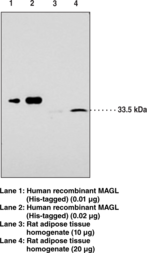服务热线
021-60498804
产品中心
/ Products Classification 点击展开+
| Cat. Number | 069838844944727 |
||||||||||||||||||||
| Chemical Name | Monoacylglycerol Lipase (FL) Polyclonal Antibody |
||||||||||||||||||||
| References |
Background ReadingDinh, T.P., Carpenter, D., Leslie, F.M., et al. Brain monoglyceride lipase participating in endocannabinoid inactivation. Proc Natl Acad Sci USA 99(16) 10819-10824 (2002). Karlsson, M., Reue, K., Xia, Y., et al. Exon- Karlsson, M., Contreras, J.A., Hellman, U., et al. cDNA cloning, tissue distribution, and identification of the catalytic triad of monoglyceride lipase. Evolutionary relationship to esterases, lysophospholipases, and haloperoxidases. J Biol Chem 272 27218-27223 (1997). Dinh, T.P., Freund, T.F., and Piomelli, D. A role for monoglyceride lipase in 2- Chon, S., Zhou, Y.X., Dixon, J.L., et al. Intestinal monoacylglycerol metabolism developmental and nutritional regulation of monoacylglycerol lipase and monoacylglycerol acyltransferase. J Biol Chem 282(46) 33346-33357 (2007). Vila, A., Rosengarth, A., Piomelli, D., et al. Hydrolysis of prostaglandin glycerol esters by the endocannabinoid-
Description
Antigen:
purified recombinant human monoacylglycerol lipase
·
Host:
rabbit
·
Application(s):
ICC, IHC, and WB
·
Endocannabinoids, such as arachidonoyl ethanolamide (AEA) and 2-
1 Dinh, T.P., Carpenter, D., Leslie, F.M., et al. Brain monoglyceride lipase participating in endocannabinoid inactivation. Proc Natl Acad Sci USA 99(16) 10819-10824 (2002).
2
Karlsson, M., Reue, K., Xia, Y., et al. Exon- 3 missing reference text
4
Dinh, T.P., Freund, T.F., and Piomelli, D. A role for monoglyceride lipase in 2- |
||||||||||||||||||||





